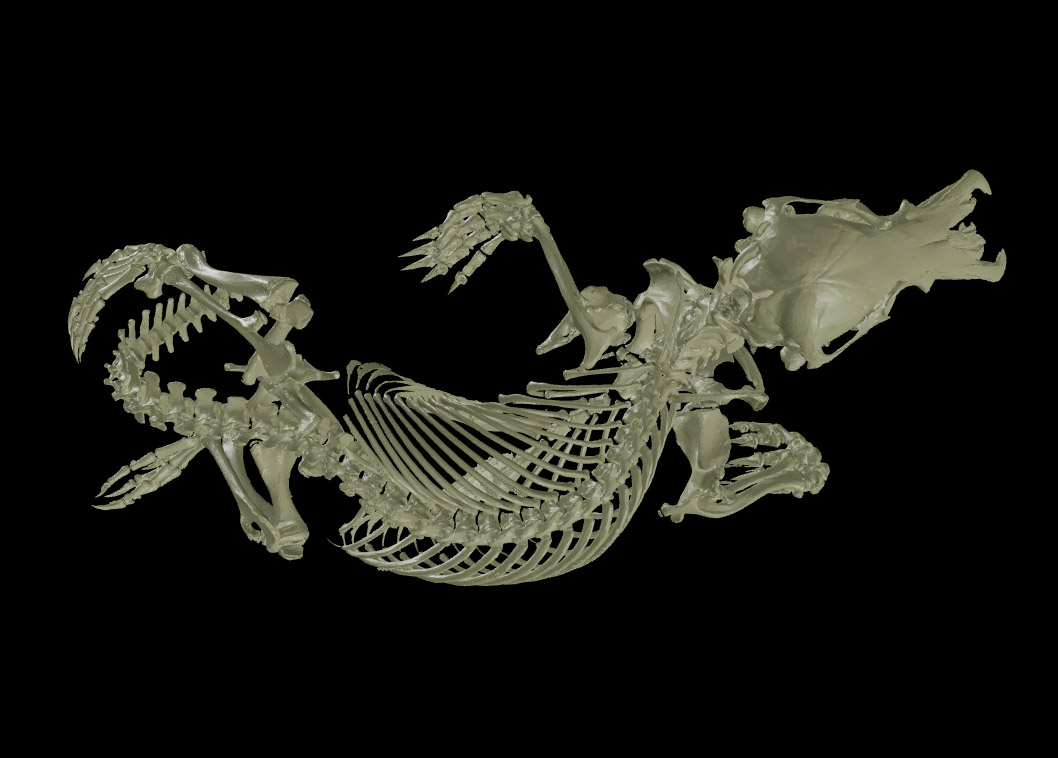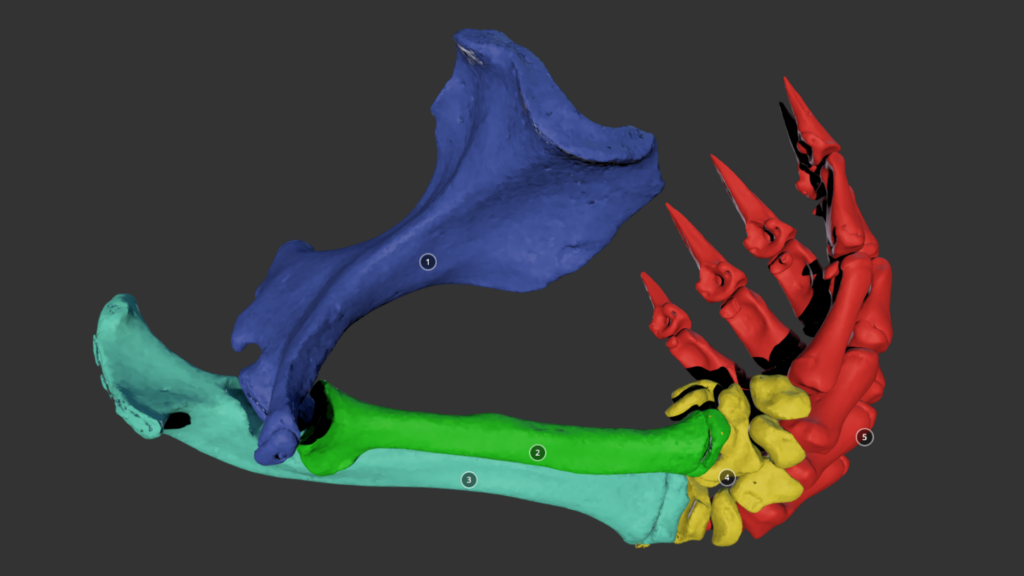Museums’ vertebrate collections go online — in 3D
CT scans of animal skeletons are now available to anyone, including those with 3D printers

Courtesy of MorphoSource and MVZ
March 7, 2024
The Museum of Vertebrate Zoology (MVZ) at the University of California, Berkeley, contains more than 300,000 vertebrate specimens — the majority of them reptiles and amphibians — preserved in alcohol and tucked away for current and future generations of scientists who want to study their anatomical and genetic diversity.
Now, those specimens are gradually gaining a new life online as part of an effort by 25 museums across the U.S. to obtain 3D scans of as many vertebrate groups as possible and make them available free to the general public in a searchable database.
A summary of the six-year project, called openVertebrate (oVert), was published this week in the journal BioScience, offering a glimpse of how the data might be used to ask new scientific questions and spur the development of innovative technology.
But scientists aren’t the only ones who find the scans useful. Artists have used the 3D models to create realistic animal replicas, photographs of oVert specimens have been displayed as museum exhibits, and specimens have been incorporated into virtual reality headsets that give users the chance to interact with and manipulate them.
Carol Spencer, staff curator of herpetology in the MVZ, has a 3D-printed version of one specimen — the skull of a horned lizard — sitting on her desk. Anyone can access the 3D scans online at MorphoSource, download the data and send them to a 3D printer to produce their own skeletal models.

Courtesy of Sketchfab and MVZ
“You can actually print them and then use them in a classroom. We have lots of people using them for teaching in colleges or high schools,” Spencer said.
Of the approximately 1,000 MVZ specimens scanned over the past six years through oVert, one — a juvenile Australian platypus, Ornithorhynchus anatinus — is the second most downloaded in the database.
“We’ve had this platypus in ethanol in a big tank, but it’s never been loaned out. The only people who have ever gone to look at this are people that come here to our collection; it’s maybe been looked at twice in its entire history here at MVZ. But in six years, it’s been downloaded 320 times,” Spencer said. “That’s a huge expansion of use.”
Spencer recently fielded a request from a professor at Towson University in Maryland to download CT scans for a course in which students compare the cranial anatomy of vertebrates and print 3D models for study.
“All of these specimens are gaining sort of a new digital life,” said Michelle Koo, the MVZ’s staff curator of biodiversity informatics. “Specimens are collected all the time, and museums have to justify taking an animal out of the wild and make sure that it has the highest value possible to current and future research. It’s part of our responsibility as curators to seek out and help keep developing these new uses and ways of accessing specimens to make sure that they stay relevant and useful for these new cutting-edge tools.”
A new digital life
Between 2017 and 2023, oVert project members led by David Blackburn at the Florida Museum of Natural History captured CT scans of more than 13,000 specimens with representative species across the vertebrate tree of life. These scans included more than half the genera of all amphibians, reptiles, fishes and mammals. CT scanners use high-energy X-rays to peer past an organism’s exterior and view the dense bone structure beneath. While skeletons make up the majority of oVert reconstructions, a small number of specimens were also stained with a temporary contrast-enhancing solution that allowed researchers to visualize soft tissues, such as skin, muscle and other organs.
The models give an intimate look at internal portions of a specimen that could previously only be observed through destructive dissection and tissue sampling, Blackburn noted.
“Museums are constantly engaged in a balancing act,” he said. “You want to protect specimens, but you also want to have people use them. oVert is a way of reducing the wear and tear on samples while also increasing access, and it’s the next logical step in the mission of museum collections.”
Because CT scans yield a series of slices through the specimen, most of the images on MorphoSource are cross-sections that must be assembled into a 3D rendering that can be spun and manipulated in a 3D viewer. But software that does this is readily available, Koo said. The CT scans resemble what she laboriously assembled as a graduate student at UC Berkeley in the 1990s, when she was studying the unique skulls of a small group of salamanders. Then, she sliced the bodies into thin sections to study the internal anatomy, but hadn’t the ability to assemble them into a 3D picture that people could readily appreciate.
“Today, I might still have to do histology, but now that we have a digital rendering of it, I can send them a picture,” Koo said. “It’s the same thing that I saw when I was looking under the microscope and trying to explain to people.”
Though funding for oVert from the National Science Foundation has ended, many museums are continuing to scan their collections, often focusing on specific groups. Spencer noted that MVZ has over 800,000 total vertebrate specimens, pickled in alcohol or dry, that could potentially be scanned and made available online.
Initially, UC Berkeley didn’t have one of the micro-CT scanners used by the oVert group, so the MVZ sent specimens to other institutions for scanning. Integrative biology professor Jack Tseng has since acquired one for projects, such as a study of fish and mammal skulls, within his department.
Spencer regularly sends MVZ specimens to other institutions where ongoing studies require a scan. She and Koo are continuing the scanning work started by oVert in a collaboration with the University of Colorado in Boulder, for example, which is leading a project to CT scan and high-resolution 2D image 1,100 species of Central American reptiles and amphibians. About 80 turtles from the MVZ are being scanned by the University of Michigan Museum of Zoology, while some of the museum’s legless lizards and cave salamanders are being scanned at other institutions for a study of their evolution. MVZ director Michael Nachman is CT scanning mice to study the connection between tail length and adaptation to heat, and the role maternal genes play in this adaptation.
“oVert’s goal was to try to get one of every genus of vertebrate. But then you don’t have all this variability within species,” Spencer said. “And so really what we need is huge data sets of multiple animals per species. And the only way we’re going to get that is if we convince everyone to make their data public through sites like MorphoSource. So when I mail specimens out to someone, and then they do CT scans, I require them to put those CT scans, when they’re done with their research, on MorphoSource so that other people can use them.”
oVert was funded with an initial sum of $2.5 million from the National Science Foundation, along with eight additional partnering grants totaling $1.1 million that were used to expand the project’s scope.